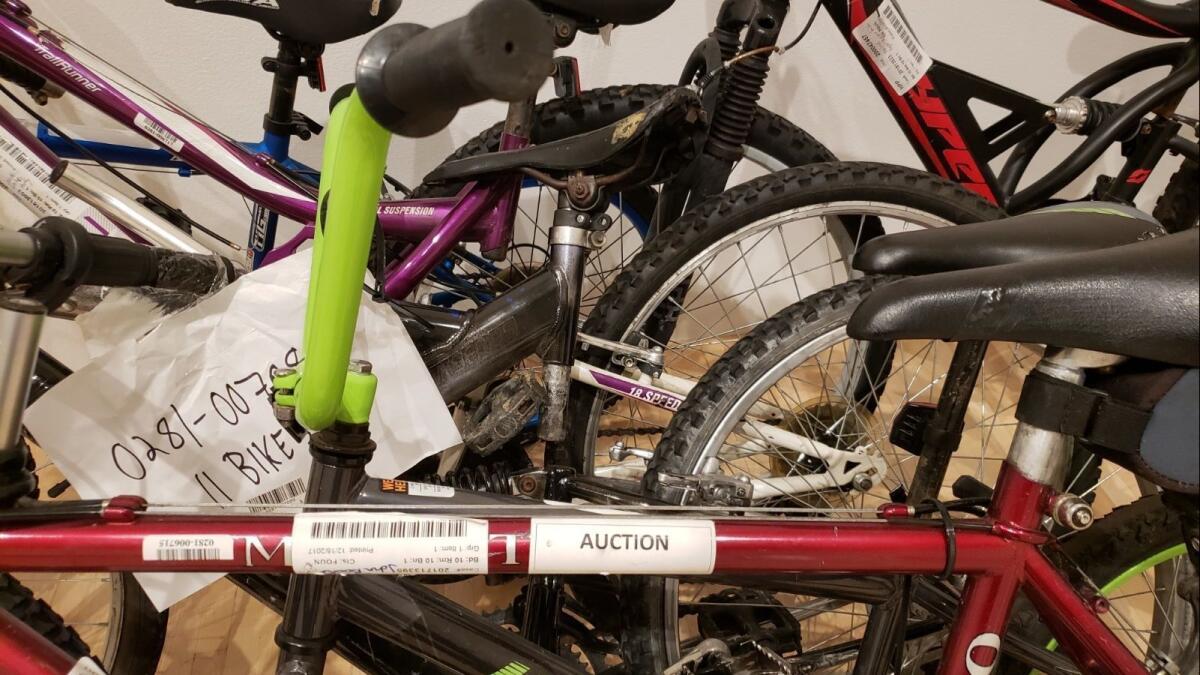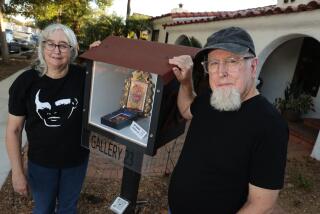Review: In Cameron Rowland’s ‘D37’ at MOCA, the legacy of slavery takes frightfully familiar forms

- Share via
With the art market a dominant behemoth tromping around in our ongoing cultural life, Cameron Rowland’s visually chilly, deceptively simple installation, “D37,” assumes an expanded resonance. The work is also about buying and selling, but the merchandise here is not traditional canvas, paint or brightly polished steel.
No, these salable goods are flesh and blood. Bicycles, a grandfather clock, a baby stroller and a couple of backpack leaf blowers are what you will see in a pristine white gallery at the Museum of Contemporary Art, where the show is on view. Those everyday objects stand in for people — human beings objectified.
The legacy of chattel slavery, which is often submerged, is the subject of “D37.” Rowland links America’s slave history to current experience.
Its history begins with the earliest European settlements and ends with the Civil War, but the legacy of the nation’s infamous “peculiar institution” lives on. Like any institution, it intersects with all manner of ordinary and un-peculiar things, which we encounter unwittingly on a daily basis. Rowland’s sharp focus makes the invisible visible.
Take the grandfather clock over in the gallery’s corner — a stately, late-18th century English timepiece of no particular aesthetic note but that once belonged to a grand South Carolina plantation. The loud chime of clocks like this one became a resonant sound that helped organize and regulate daily life, including forced work-details on the estate. Rowland’s choice of a specifically British grandfather clock establishes a subtle but trenchant familial link to the mother country, principal market for the exports of cotton and tobacco on which the South relied.
Demand meets supply, however cruelly produced, as time marches on.
Hanging nearby, framed tax receipts from Mississippi and Virginia record revenues gained between 1848 and 1860, when states taxed plantation assets — land, livestock, clocks, human beings held as property and worked to death — to fund their governments’ operations. When South Carolina lighted the Civil War fuse in 1860, the economic value of slaves in the United States exceeded the invested value of all of the nation’s railroads, factories and banks combined.
The legacy of the South’s agriculturally based slave economy is manifold, but one feature that lived on into the modern era evolved from that stately timepiece, standing like a sentinel out in the plantation’s hallway and now enshrined in a museum. In large 20th century factories and offices, a central pendulum clock was commonly connected to and synchronized with smaller clocks scattered around the building, so that workers would be on the same industrialized schedule set by the employer. Tellingly, the colloquial terms for these timepieces were the master clock and the slave clocks.
Rowland’s show is composed solely from found objects. They’re descendants of the industrially manufactured Readymade sculptures that Marcel Duchamp pioneered a century ago and that have been utilized by diverse Conceptual artists since the 1960s.
Artists like Betye Saar and David Hammons are among his forebears. And he draws on techniques of institutional critique established by the late L.A.-based artist Michael Asher, as well as Hans Haacke’s well-known 1971 photo-and-text work unveiling abusive economic systems embedded in New York City real estate transactions.
The word “found,” however, often has a casual, informal air — as if the object had been stumbled upon and its aesthetic possibilities suddenly recognized by an insightful artist. That’s often not the case, and it’s especially untrue here.
These objects did already exist, but they were carefully searched out and juxtaposed. The show’s used bicycles and leaf blowers, now idly piled against walls and laid out on the floor, push the slave economy narrative forward. The leaf blowers alone conjure today’s exploitation of Latinx underground labor.
Visitors are given a detailed booklet that identifies the objects’ source — property seized by police and sold at auction. One blower sold for $206, 11 used bikes went for $287, etc.
Sometimes the booklet would benefit from further explication, as when Rowland also compiled a fat, spring-bound volume that records nearly $300 million in property and cash seized in U.S. civil asset forfeitures in 2017. (A copy is available downstairs in MOCA’s education room.) The scale of the subject gets physical heft.
The booklet explains that the controversial system of asset forfeiture, used to fund police departments and here empathetically embodied in battered and forlorn objects, originated in 400-year-old British laws. They were shaped to regulate commerce between England, its colonies and the West African slave trade.
The show’s title work zooms out to encompass the entire museum.
“D37” designates the Bunker Hill land parcel on which the art museum was built — a parcel itemized in famously racist 1939 federal maps that redlined cities such as Los Angeles and that was later seized for redevelopment by eminent domain. The same maps chart the moral debt itemized by writer Ta-Nehisi Coates in his brilliant 2014 Atlantic magazine polemic, “The Case for Reparations.”
Rowland’s show, installed deep within MOCA’s permanent collection rooms, quietly but firmly italicizes questions of art and property, including his and the museum’s. The designated found object for “D37” is the patrons’ donor plaque affixed on a wall outside at the museum’s entry stair.
In the final piece, the artist zooms in, bringing the issue home.
Displayed documents show that in August he bought an acre of land at the South Carolina shore. The wooded parcel is in a region where some 40,000 African Americans once briefly lived, taking advantage of the government’s post-Civil War “40 acres and a mule” pledge.
North Carolina-born President Andrew Johnson soon overturned that slave-reparation, evicting the impoverished freedmen. Rowland paid $38,000 for the parcel, applied a host of restrictive covenants to the deal that drained the property’s development potential and collapsed its appraised value to zero.
To underscore the blistering economic point, Rowland will rent some examples of his work to art collectors for five-year periods at cost — $206 for that blower, $287 for the 11 bikes — after which title reverts to the artist. Today’s raging art and auction markets are neatly absorbed into the social dialogue so incisively tackled in his work.
“D37” was organized by MOCA curator Lanka Tattersall and curatorial assistant Rebecca Lowery. It’s the first solo exhibition in an American museum for the 30-year-old artist, who is based in New York. Expect it not to be the last.
♦ ♦ ♦ ♦ ♦ ♦ ♦ ♦ ♦ ♦
‘D37’
Where: Museum of Contemporary Art, 250 S. Grand Ave., L.A.
When: Through March 11; closed Tuesday
Admission: $8-$15
Info: (213) 626-6222, moca.org
More to Read
The biggest entertainment stories
Get our big stories about Hollywood, film, television, music, arts, culture and more right in your inbox as soon as they publish.
You may occasionally receive promotional content from the Los Angeles Times.











